Research Project: Digital Technology's Impact on SME Business Activity
VerifiedAdded on 2020/12/18
|12
|3438
|357
Report
AI Summary
This report presents a research project examining the impact of digital technology, particularly cloud computing, on the business activities of Small and Medium Enterprises (SMEs), with a specific case study on Ensoft Limited. The introduction outlines the importance of digital technology, especially cloud computing, in modern business operations. Task 1 focuses on the research proposal, defining the research question, objectives, and literature review on cloud technology, its significance, challenges, and impact on information storage. Task 2 delves into the research methodologies, differentiating between qualitative and quantitative research, and the types of data collection methods used, including primary and secondary research. The report aims to analyze the impact of cloud technology in administrating business activities, identifying the concept, significance, challenges, and impact on information storage within organizations like Ensoft Limited, which provides software solutions and networking. The research employs literature review, case study and various methods for data collection to find solutions. The report discusses the benefits, challenges and the role of cloud technology in managing entire business processes effectively.
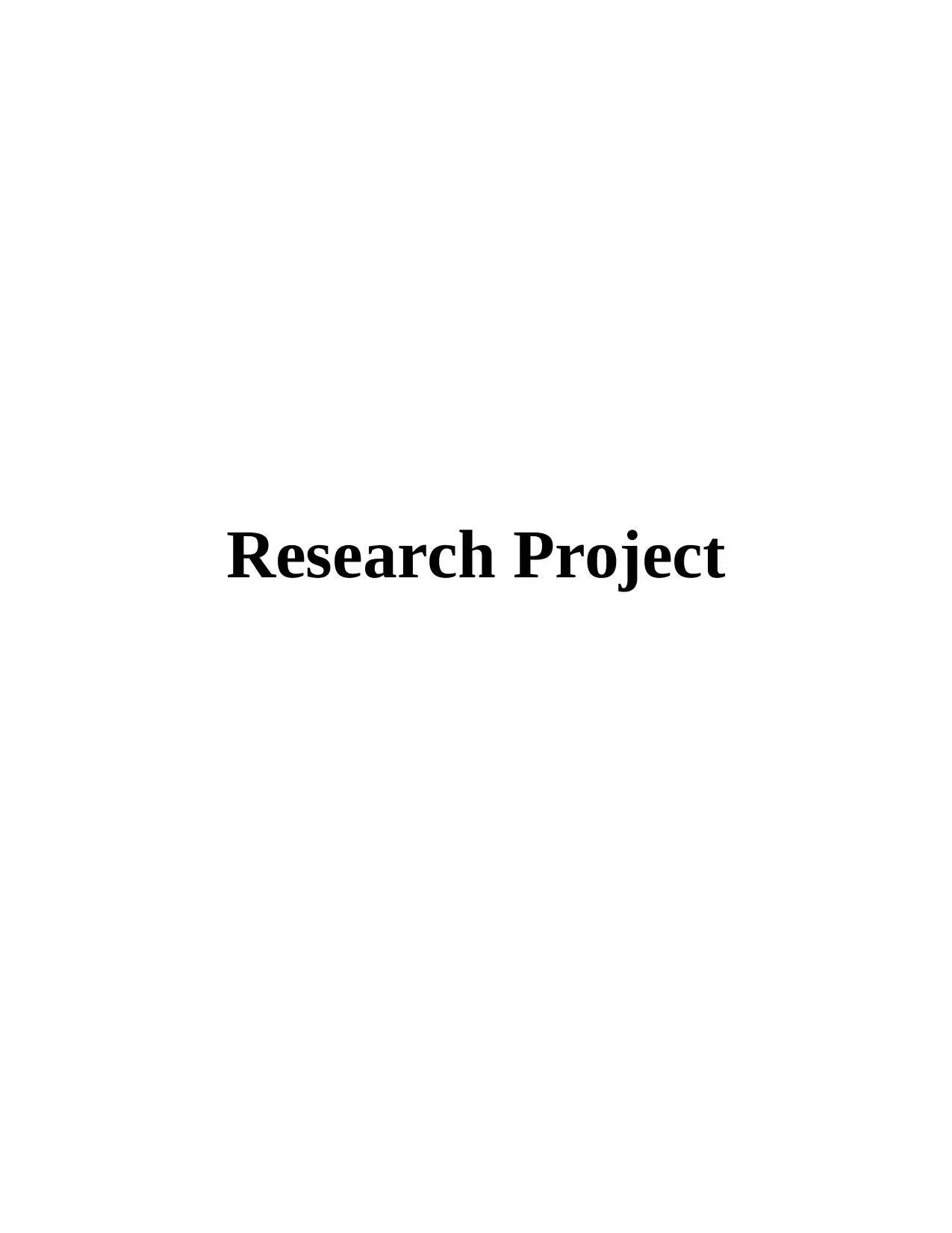
Research Project
Paraphrase This Document
Need a fresh take? Get an instant paraphrase of this document with our AI Paraphraser
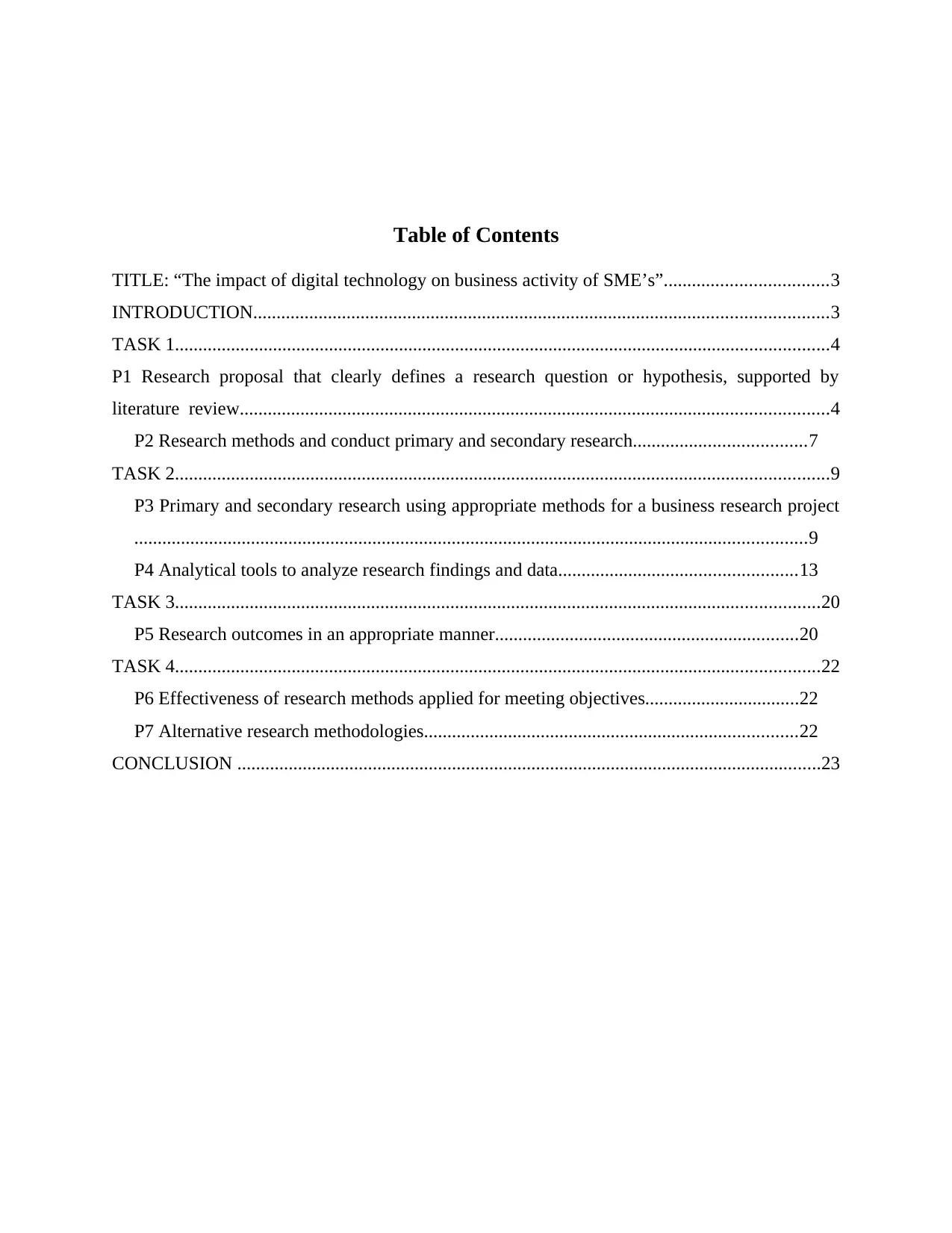
Table of Contents
TITLE: “The impact of digital technology on business activity of SME’s”...................................3
INTRODUCTION...........................................................................................................................3
TASK 1............................................................................................................................................4
P1 Research proposal that clearly defines a research question or hypothesis, supported by
literature review..............................................................................................................................4
P2 Research methods and conduct primary and secondary research.....................................7
TASK 2............................................................................................................................................9
P3 Primary and secondary research using appropriate methods for a business research project
................................................................................................................................................9
P4 Analytical tools to analyze research findings and data...................................................13
TASK 3..........................................................................................................................................20
P5 Research outcomes in an appropriate manner.................................................................20
TASK 4..........................................................................................................................................22
P6 Effectiveness of research methods applied for meeting objectives.................................22
P7 Alternative research methodologies................................................................................22
CONCLUSION .............................................................................................................................23
TITLE: “The impact of digital technology on business activity of SME’s”...................................3
INTRODUCTION...........................................................................................................................3
TASK 1............................................................................................................................................4
P1 Research proposal that clearly defines a research question or hypothesis, supported by
literature review..............................................................................................................................4
P2 Research methods and conduct primary and secondary research.....................................7
TASK 2............................................................................................................................................9
P3 Primary and secondary research using appropriate methods for a business research project
................................................................................................................................................9
P4 Analytical tools to analyze research findings and data...................................................13
TASK 3..........................................................................................................................................20
P5 Research outcomes in an appropriate manner.................................................................20
TASK 4..........................................................................................................................................22
P6 Effectiveness of research methods applied for meeting objectives.................................22
P7 Alternative research methodologies................................................................................22
CONCLUSION .............................................................................................................................23
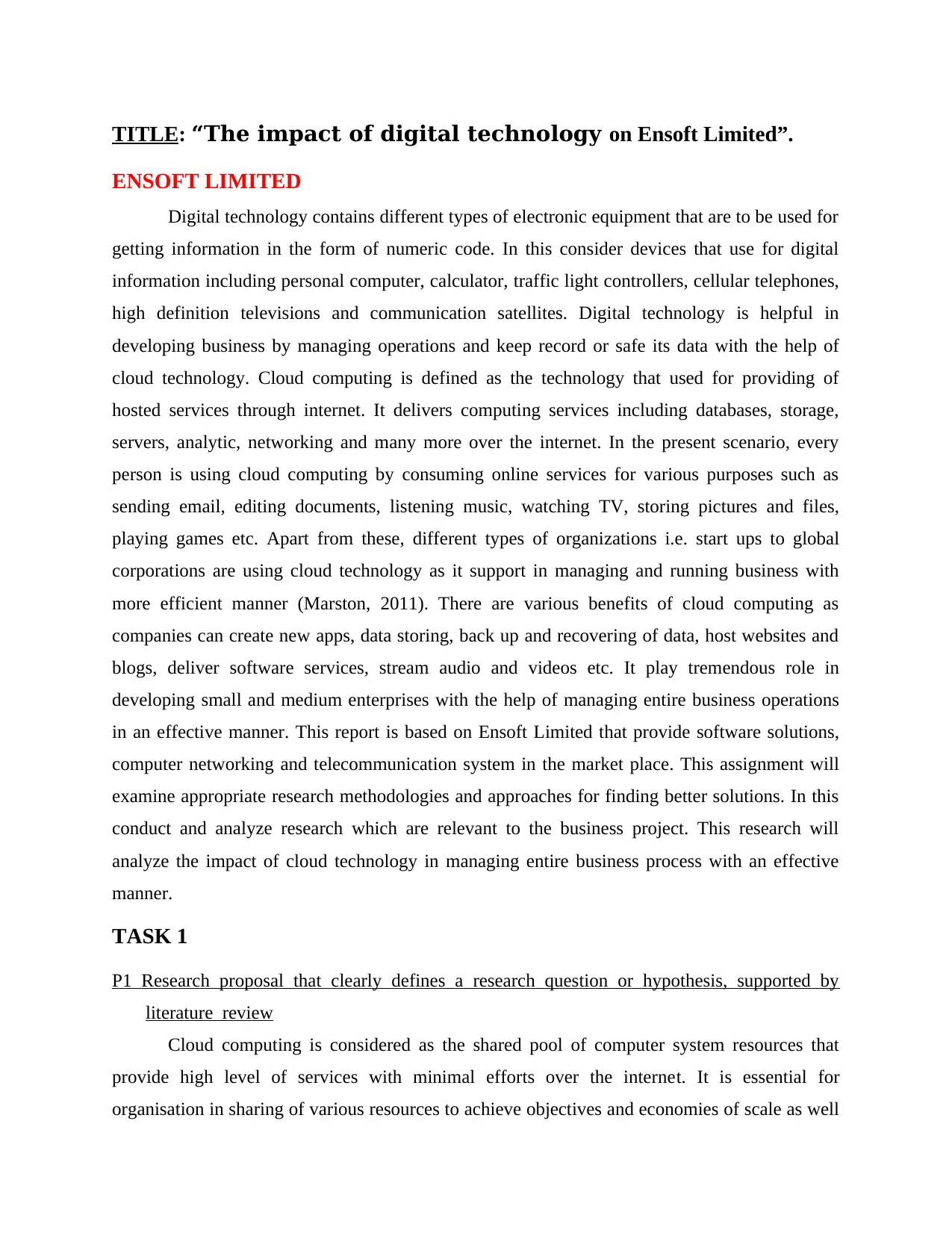
TITLE: “The impact of digital technology on Ensoft Limited”.
ENSOFT LIMITED
Digital technology contains different types of electronic equipment that are to be used for
getting information in the form of numeric code. In this consider devices that use for digital
information including personal computer, calculator, traffic light controllers, cellular telephones,
high definition televisions and communication satellites. Digital technology is helpful in
developing business by managing operations and keep record or safe its data with the help of
cloud technology. Cloud computing is defined as the technology that used for providing of
hosted services through internet. It delivers computing services including databases, storage,
servers, analytic, networking and many more over the internet. In the present scenario, every
person is using cloud computing by consuming online services for various purposes such as
sending email, editing documents, listening music, watching TV, storing pictures and files,
playing games etc. Apart from these, different types of organizations i.e. start ups to global
corporations are using cloud technology as it support in managing and running business with
more efficient manner (Marston, 2011). There are various benefits of cloud computing as
companies can create new apps, data storing, back up and recovering of data, host websites and
blogs, deliver software services, stream audio and videos etc. It play tremendous role in
developing small and medium enterprises with the help of managing entire business operations
in an effective manner. This report is based on Ensoft Limited that provide software solutions,
computer networking and telecommunication system in the market place. This assignment will
examine appropriate research methodologies and approaches for finding better solutions. In this
conduct and analyze research which are relevant to the business project. This research will
analyze the impact of cloud technology in managing entire business process with an effective
manner.
TASK 1
P1 Research proposal that clearly defines a research question or hypothesis, supported by
literature review
Cloud computing is considered as the shared pool of computer system resources that
provide high level of services with minimal efforts over the internet. It is essential for
organisation in sharing of various resources to achieve objectives and economies of scale as well
ENSOFT LIMITED
Digital technology contains different types of electronic equipment that are to be used for
getting information in the form of numeric code. In this consider devices that use for digital
information including personal computer, calculator, traffic light controllers, cellular telephones,
high definition televisions and communication satellites. Digital technology is helpful in
developing business by managing operations and keep record or safe its data with the help of
cloud technology. Cloud computing is defined as the technology that used for providing of
hosted services through internet. It delivers computing services including databases, storage,
servers, analytic, networking and many more over the internet. In the present scenario, every
person is using cloud computing by consuming online services for various purposes such as
sending email, editing documents, listening music, watching TV, storing pictures and files,
playing games etc. Apart from these, different types of organizations i.e. start ups to global
corporations are using cloud technology as it support in managing and running business with
more efficient manner (Marston, 2011). There are various benefits of cloud computing as
companies can create new apps, data storing, back up and recovering of data, host websites and
blogs, deliver software services, stream audio and videos etc. It play tremendous role in
developing small and medium enterprises with the help of managing entire business operations
in an effective manner. This report is based on Ensoft Limited that provide software solutions,
computer networking and telecommunication system in the market place. This assignment will
examine appropriate research methodologies and approaches for finding better solutions. In this
conduct and analyze research which are relevant to the business project. This research will
analyze the impact of cloud technology in managing entire business process with an effective
manner.
TASK 1
P1 Research proposal that clearly defines a research question or hypothesis, supported by
literature review
Cloud computing is considered as the shared pool of computer system resources that
provide high level of services with minimal efforts over the internet. It is essential for
organisation in sharing of various resources to achieve objectives and economies of scale as well
⊘ This is a preview!⊘
Do you want full access?
Subscribe today to unlock all pages.

Trusted by 1+ million students worldwide
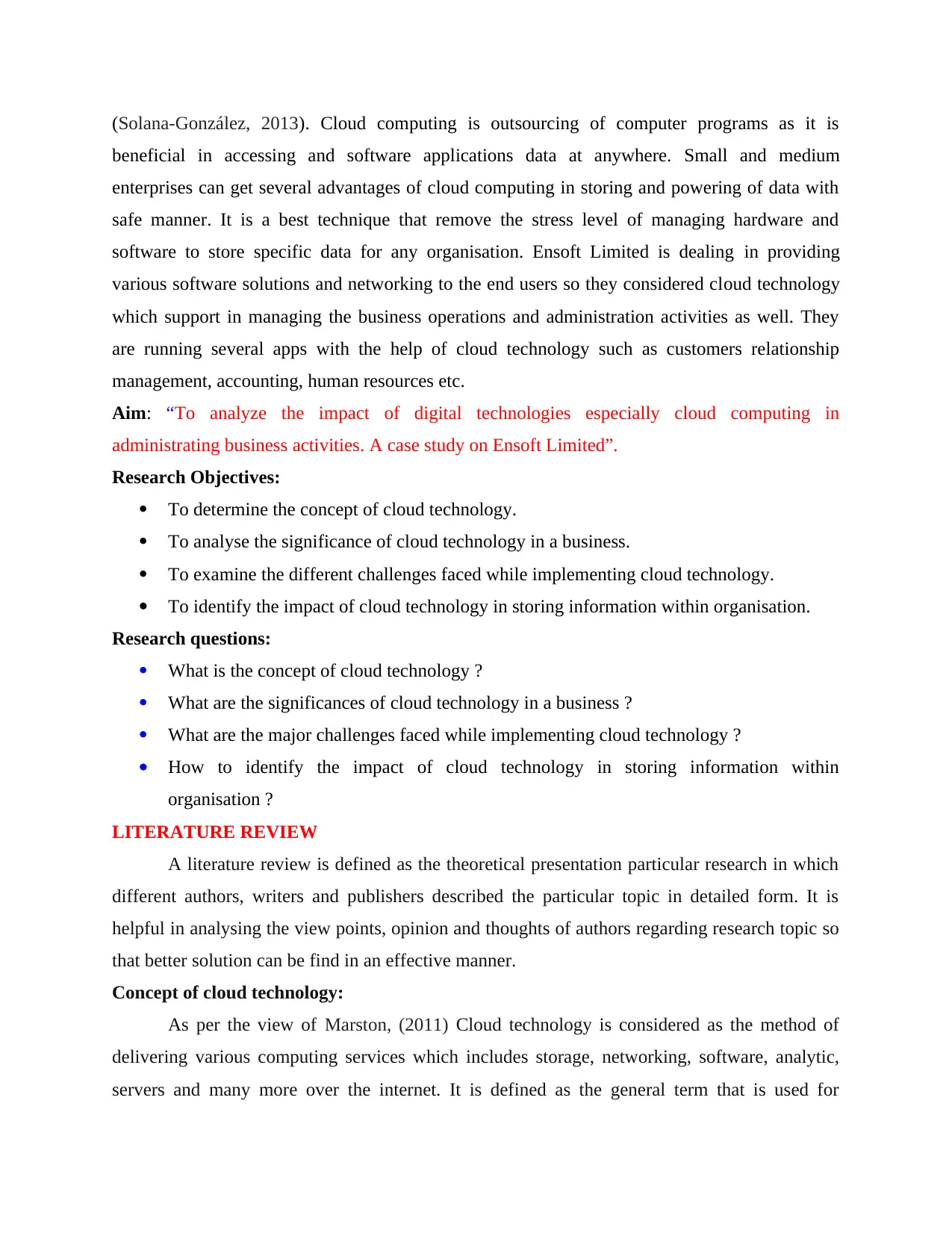
(Solana-González, 2013). Cloud computing is outsourcing of computer programs as it is
beneficial in accessing and software applications data at anywhere. Small and medium
enterprises can get several advantages of cloud computing in storing and powering of data with
safe manner. It is a best technique that remove the stress level of managing hardware and
software to store specific data for any organisation. Ensoft Limited is dealing in providing
various software solutions and networking to the end users so they considered cloud technology
which support in managing the business operations and administration activities as well. They
are running several apps with the help of cloud technology such as customers relationship
management, accounting, human resources etc.
Aim: “To analyze the impact of digital technologies especially cloud computing in
administrating business activities. A case study on Ensoft Limited”.
Research Objectives:
To determine the concept of cloud technology.
To analyse the significance of cloud technology in a business.
To examine the different challenges faced while implementing cloud technology.
To identify the impact of cloud technology in storing information within organisation.
Research questions:
What is the concept of cloud technology ?
What are the significances of cloud technology in a business ?
What are the major challenges faced while implementing cloud technology ?
How to identify the impact of cloud technology in storing information within
organisation ?
LITERATURE REVIEW
A literature review is defined as the theoretical presentation particular research in which
different authors, writers and publishers described the particular topic in detailed form. It is
helpful in analysing the view points, opinion and thoughts of authors regarding research topic so
that better solution can be find in an effective manner.
Concept of cloud technology:
As per the view of Marston, (2011) Cloud technology is considered as the method of
delivering various computing services which includes storage, networking, software, analytic,
servers and many more over the internet. It is defined as the general term that is used for
beneficial in accessing and software applications data at anywhere. Small and medium
enterprises can get several advantages of cloud computing in storing and powering of data with
safe manner. It is a best technique that remove the stress level of managing hardware and
software to store specific data for any organisation. Ensoft Limited is dealing in providing
various software solutions and networking to the end users so they considered cloud technology
which support in managing the business operations and administration activities as well. They
are running several apps with the help of cloud technology such as customers relationship
management, accounting, human resources etc.
Aim: “To analyze the impact of digital technologies especially cloud computing in
administrating business activities. A case study on Ensoft Limited”.
Research Objectives:
To determine the concept of cloud technology.
To analyse the significance of cloud technology in a business.
To examine the different challenges faced while implementing cloud technology.
To identify the impact of cloud technology in storing information within organisation.
Research questions:
What is the concept of cloud technology ?
What are the significances of cloud technology in a business ?
What are the major challenges faced while implementing cloud technology ?
How to identify the impact of cloud technology in storing information within
organisation ?
LITERATURE REVIEW
A literature review is defined as the theoretical presentation particular research in which
different authors, writers and publishers described the particular topic in detailed form. It is
helpful in analysing the view points, opinion and thoughts of authors regarding research topic so
that better solution can be find in an effective manner.
Concept of cloud technology:
As per the view of Marston, (2011) Cloud technology is considered as the method of
delivering various computing services which includes storage, networking, software, analytic,
servers and many more over the internet. It is defined as the general term that is used for
Paraphrase This Document
Need a fresh take? Get an instant paraphrase of this document with our AI Paraphraser
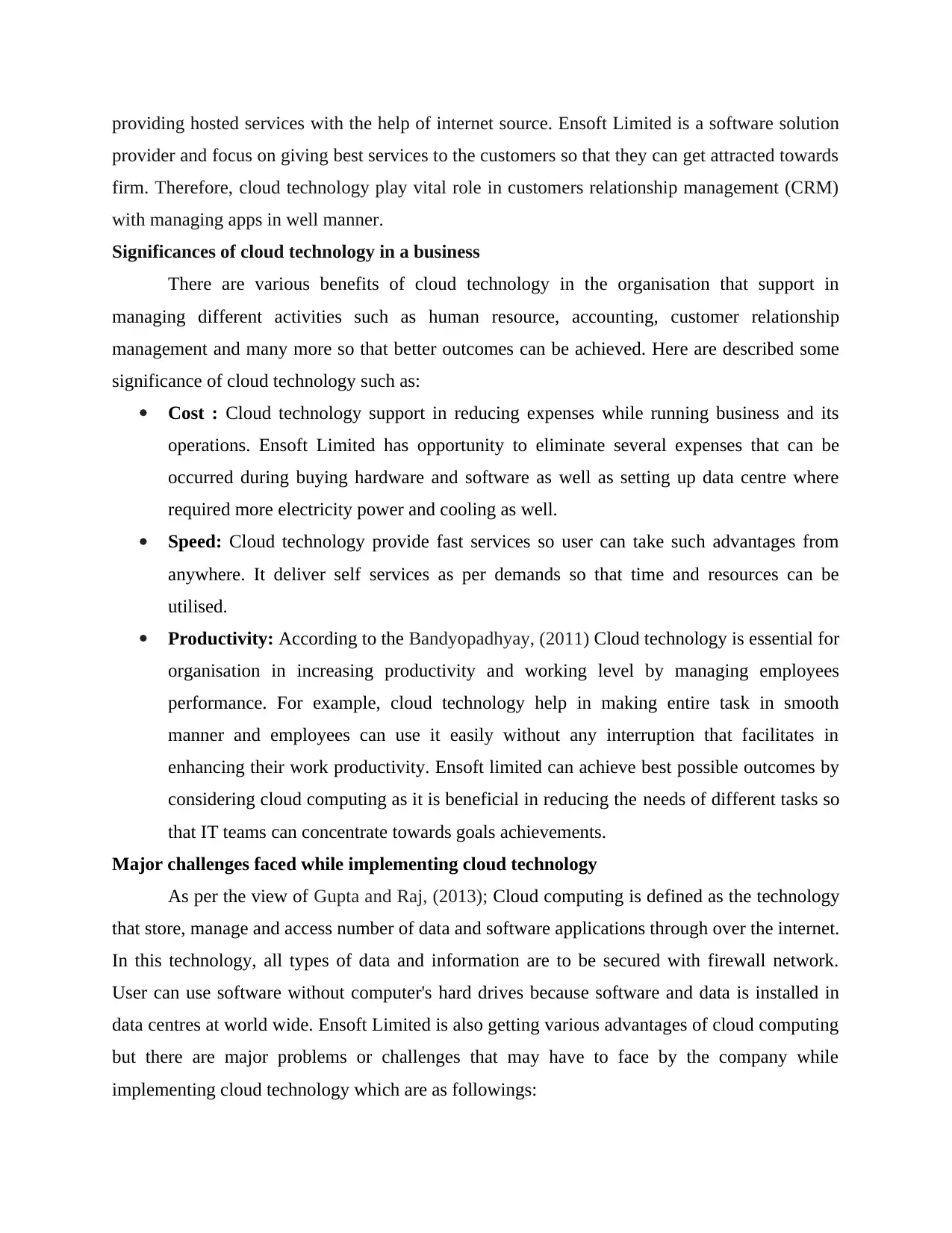
providing hosted services with the help of internet source. Ensoft Limited is a software solution
provider and focus on giving best services to the customers so that they can get attracted towards
firm. Therefore, cloud technology play vital role in customers relationship management (CRM)
with managing apps in well manner.
Significances of cloud technology in a business
There are various benefits of cloud technology in the organisation that support in
managing different activities such as human resource, accounting, customer relationship
management and many more so that better outcomes can be achieved. Here are described some
significance of cloud technology such as:
Cost : Cloud technology support in reducing expenses while running business and its
operations. Ensoft Limited has opportunity to eliminate several expenses that can be
occurred during buying hardware and software as well as setting up data centre where
required more electricity power and cooling as well.
Speed: Cloud technology provide fast services so user can take such advantages from
anywhere. It deliver self services as per demands so that time and resources can be
utilised.
Productivity: According to the Bandyopadhyay, (2011) Cloud technology is essential for
organisation in increasing productivity and working level by managing employees
performance. For example, cloud technology help in making entire task in smooth
manner and employees can use it easily without any interruption that facilitates in
enhancing their work productivity. Ensoft limited can achieve best possible outcomes by
considering cloud computing as it is beneficial in reducing the needs of different tasks so
that IT teams can concentrate towards goals achievements.
Major challenges faced while implementing cloud technology
As per the view of Gupta and Raj, (2013); Cloud computing is defined as the technology
that store, manage and access number of data and software applications through over the internet.
In this technology, all types of data and information are to be secured with firewall network.
User can use software without computer's hard drives because software and data is installed in
data centres at world wide. Ensoft Limited is also getting various advantages of cloud computing
but there are major problems or challenges that may have to face by the company while
implementing cloud technology which are as followings:
provider and focus on giving best services to the customers so that they can get attracted towards
firm. Therefore, cloud technology play vital role in customers relationship management (CRM)
with managing apps in well manner.
Significances of cloud technology in a business
There are various benefits of cloud technology in the organisation that support in
managing different activities such as human resource, accounting, customer relationship
management and many more so that better outcomes can be achieved. Here are described some
significance of cloud technology such as:
Cost : Cloud technology support in reducing expenses while running business and its
operations. Ensoft Limited has opportunity to eliminate several expenses that can be
occurred during buying hardware and software as well as setting up data centre where
required more electricity power and cooling as well.
Speed: Cloud technology provide fast services so user can take such advantages from
anywhere. It deliver self services as per demands so that time and resources can be
utilised.
Productivity: According to the Bandyopadhyay, (2011) Cloud technology is essential for
organisation in increasing productivity and working level by managing employees
performance. For example, cloud technology help in making entire task in smooth
manner and employees can use it easily without any interruption that facilitates in
enhancing their work productivity. Ensoft limited can achieve best possible outcomes by
considering cloud computing as it is beneficial in reducing the needs of different tasks so
that IT teams can concentrate towards goals achievements.
Major challenges faced while implementing cloud technology
As per the view of Gupta and Raj, (2013); Cloud computing is defined as the technology
that store, manage and access number of data and software applications through over the internet.
In this technology, all types of data and information are to be secured with firewall network.
User can use software without computer's hard drives because software and data is installed in
data centres at world wide. Ensoft Limited is also getting various advantages of cloud computing
but there are major problems or challenges that may have to face by the company while
implementing cloud technology which are as followings:
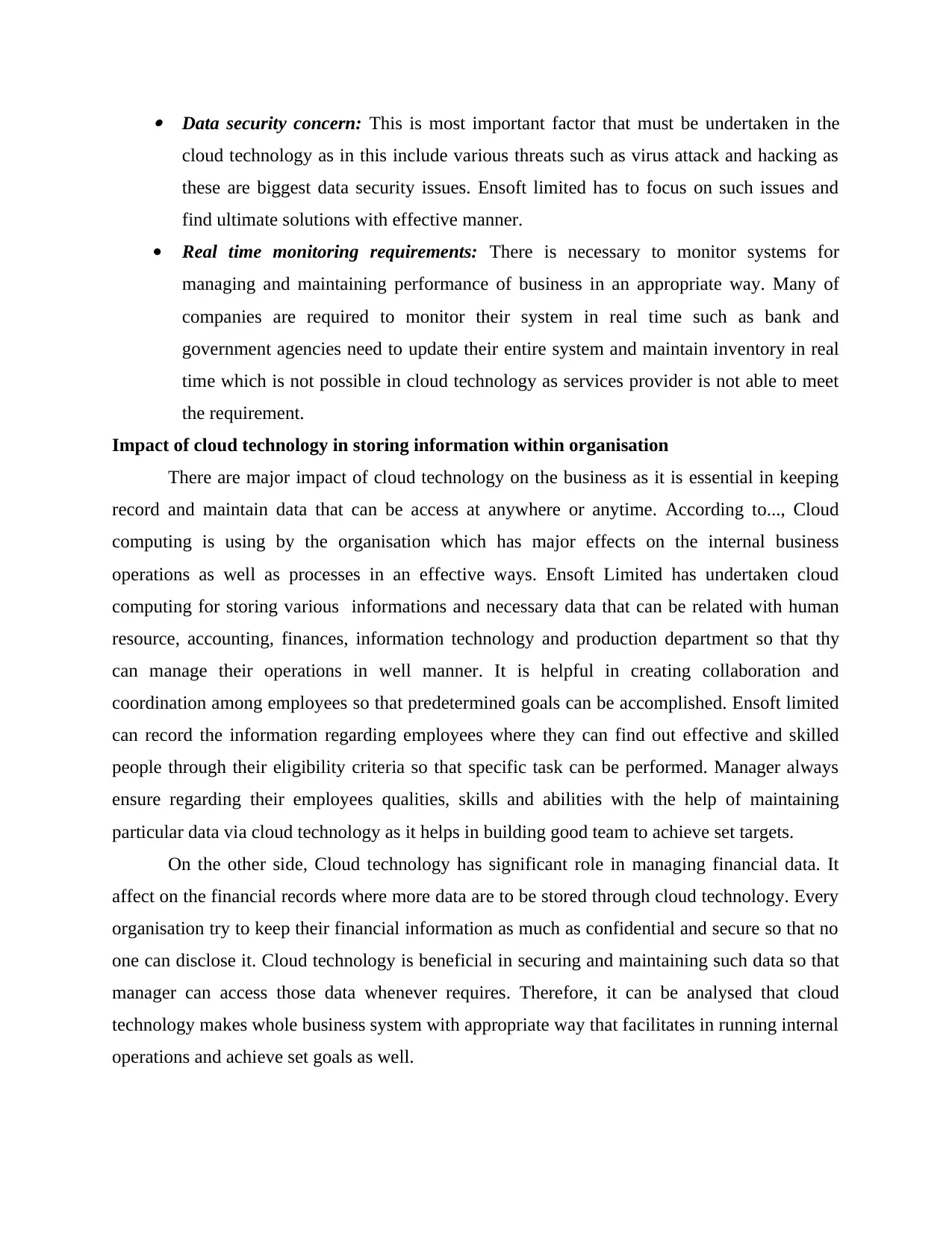
Data security concern: This is most important factor that must be undertaken in the
cloud technology as in this include various threats such as virus attack and hacking as
these are biggest data security issues. Ensoft limited has to focus on such issues and
find ultimate solutions with effective manner.
Real time monitoring requirements: There is necessary to monitor systems for
managing and maintaining performance of business in an appropriate way. Many of
companies are required to monitor their system in real time such as bank and
government agencies need to update their entire system and maintain inventory in real
time which is not possible in cloud technology as services provider is not able to meet
the requirement.
Impact of cloud technology in storing information within organisation
There are major impact of cloud technology on the business as it is essential in keeping
record and maintain data that can be access at anywhere or anytime. According to..., Cloud
computing is using by the organisation which has major effects on the internal business
operations as well as processes in an effective ways. Ensoft Limited has undertaken cloud
computing for storing various informations and necessary data that can be related with human
resource, accounting, finances, information technology and production department so that thy
can manage their operations in well manner. It is helpful in creating collaboration and
coordination among employees so that predetermined goals can be accomplished. Ensoft limited
can record the information regarding employees where they can find out effective and skilled
people through their eligibility criteria so that specific task can be performed. Manager always
ensure regarding their employees qualities, skills and abilities with the help of maintaining
particular data via cloud technology as it helps in building good team to achieve set targets.
On the other side, Cloud technology has significant role in managing financial data. It
affect on the financial records where more data are to be stored through cloud technology. Every
organisation try to keep their financial information as much as confidential and secure so that no
one can disclose it. Cloud technology is beneficial in securing and maintaining such data so that
manager can access those data whenever requires. Therefore, it can be analysed that cloud
technology makes whole business system with appropriate way that facilitates in running internal
operations and achieve set goals as well.
cloud technology as in this include various threats such as virus attack and hacking as
these are biggest data security issues. Ensoft limited has to focus on such issues and
find ultimate solutions with effective manner.
Real time monitoring requirements: There is necessary to monitor systems for
managing and maintaining performance of business in an appropriate way. Many of
companies are required to monitor their system in real time such as bank and
government agencies need to update their entire system and maintain inventory in real
time which is not possible in cloud technology as services provider is not able to meet
the requirement.
Impact of cloud technology in storing information within organisation
There are major impact of cloud technology on the business as it is essential in keeping
record and maintain data that can be access at anywhere or anytime. According to..., Cloud
computing is using by the organisation which has major effects on the internal business
operations as well as processes in an effective ways. Ensoft Limited has undertaken cloud
computing for storing various informations and necessary data that can be related with human
resource, accounting, finances, information technology and production department so that thy
can manage their operations in well manner. It is helpful in creating collaboration and
coordination among employees so that predetermined goals can be accomplished. Ensoft limited
can record the information regarding employees where they can find out effective and skilled
people through their eligibility criteria so that specific task can be performed. Manager always
ensure regarding their employees qualities, skills and abilities with the help of maintaining
particular data via cloud technology as it helps in building good team to achieve set targets.
On the other side, Cloud technology has significant role in managing financial data. It
affect on the financial records where more data are to be stored through cloud technology. Every
organisation try to keep their financial information as much as confidential and secure so that no
one can disclose it. Cloud technology is beneficial in securing and maintaining such data so that
manager can access those data whenever requires. Therefore, it can be analysed that cloud
technology makes whole business system with appropriate way that facilitates in running internal
operations and achieve set goals as well.
⊘ This is a preview!⊘
Do you want full access?
Subscribe today to unlock all pages.

Trusted by 1+ million students worldwide
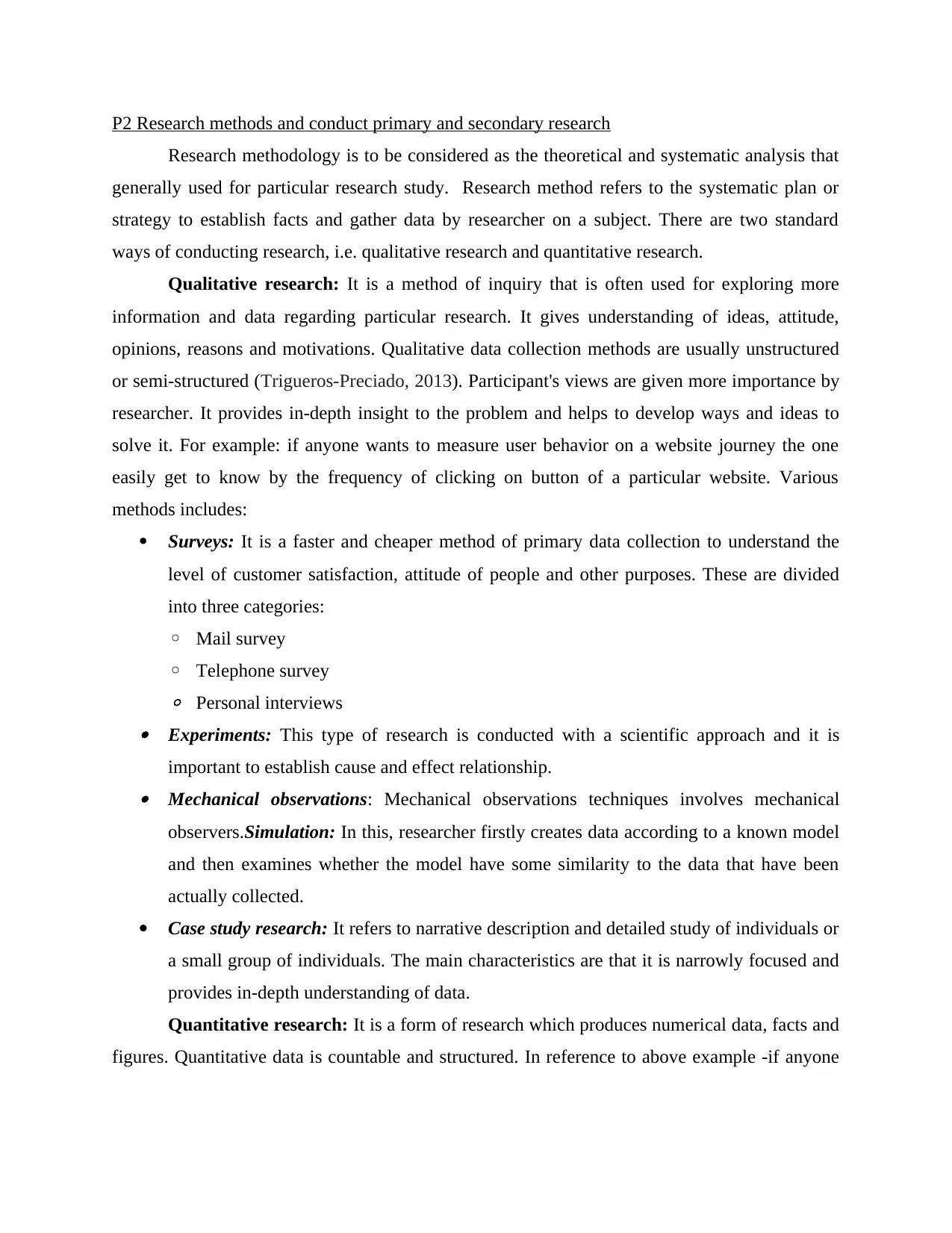
P2 Research methods and conduct primary and secondary research
Research methodology is to be considered as the theoretical and systematic analysis that
generally used for particular research study. Research method refers to the systematic plan or
strategy to establish facts and gather data by researcher on a subject. There are two standard
ways of conducting research, i.e. qualitative research and quantitative research.
Qualitative research: It is a method of inquiry that is often used for exploring more
information and data regarding particular research. It gives understanding of ideas, attitude,
opinions, reasons and motivations. Qualitative data collection methods are usually unstructured
or semi-structured (Trigueros-Preciado, 2013). Participant's views are given more importance by
researcher. It provides in-depth insight to the problem and helps to develop ways and ideas to
solve it. For example: if anyone wants to measure user behavior on a website journey the one
easily get to know by the frequency of clicking on button of a particular website. Various
methods includes:
Surveys: It is a faster and cheaper method of primary data collection to understand the
level of customer satisfaction, attitude of people and other purposes. These are divided
into three categories:
◦ Mail survey
◦ Telephone survey
◦ Personal interviews Experiments: This type of research is conducted with a scientific approach and it is
important to establish cause and effect relationship. Mechanical observations: Mechanical observations techniques involves mechanical
observers.Simulation: In this, researcher firstly creates data according to a known model
and then examines whether the model have some similarity to the data that have been
actually collected.
Case study research: It refers to narrative description and detailed study of individuals or
a small group of individuals. The main characteristics are that it is narrowly focused and
provides in-depth understanding of data.
Quantitative research: It is a form of research which produces numerical data, facts and
figures. Quantitative data is countable and structured. In reference to above example -if anyone
Research methodology is to be considered as the theoretical and systematic analysis that
generally used for particular research study. Research method refers to the systematic plan or
strategy to establish facts and gather data by researcher on a subject. There are two standard
ways of conducting research, i.e. qualitative research and quantitative research.
Qualitative research: It is a method of inquiry that is often used for exploring more
information and data regarding particular research. It gives understanding of ideas, attitude,
opinions, reasons and motivations. Qualitative data collection methods are usually unstructured
or semi-structured (Trigueros-Preciado, 2013). Participant's views are given more importance by
researcher. It provides in-depth insight to the problem and helps to develop ways and ideas to
solve it. For example: if anyone wants to measure user behavior on a website journey the one
easily get to know by the frequency of clicking on button of a particular website. Various
methods includes:
Surveys: It is a faster and cheaper method of primary data collection to understand the
level of customer satisfaction, attitude of people and other purposes. These are divided
into three categories:
◦ Mail survey
◦ Telephone survey
◦ Personal interviews Experiments: This type of research is conducted with a scientific approach and it is
important to establish cause and effect relationship. Mechanical observations: Mechanical observations techniques involves mechanical
observers.Simulation: In this, researcher firstly creates data according to a known model
and then examines whether the model have some similarity to the data that have been
actually collected.
Case study research: It refers to narrative description and detailed study of individuals or
a small group of individuals. The main characteristics are that it is narrowly focused and
provides in-depth understanding of data.
Quantitative research: It is a form of research which produces numerical data, facts and
figures. Quantitative data is countable and structured. In reference to above example -if anyone
Paraphrase This Document
Need a fresh take? Get an instant paraphrase of this document with our AI Paraphraser
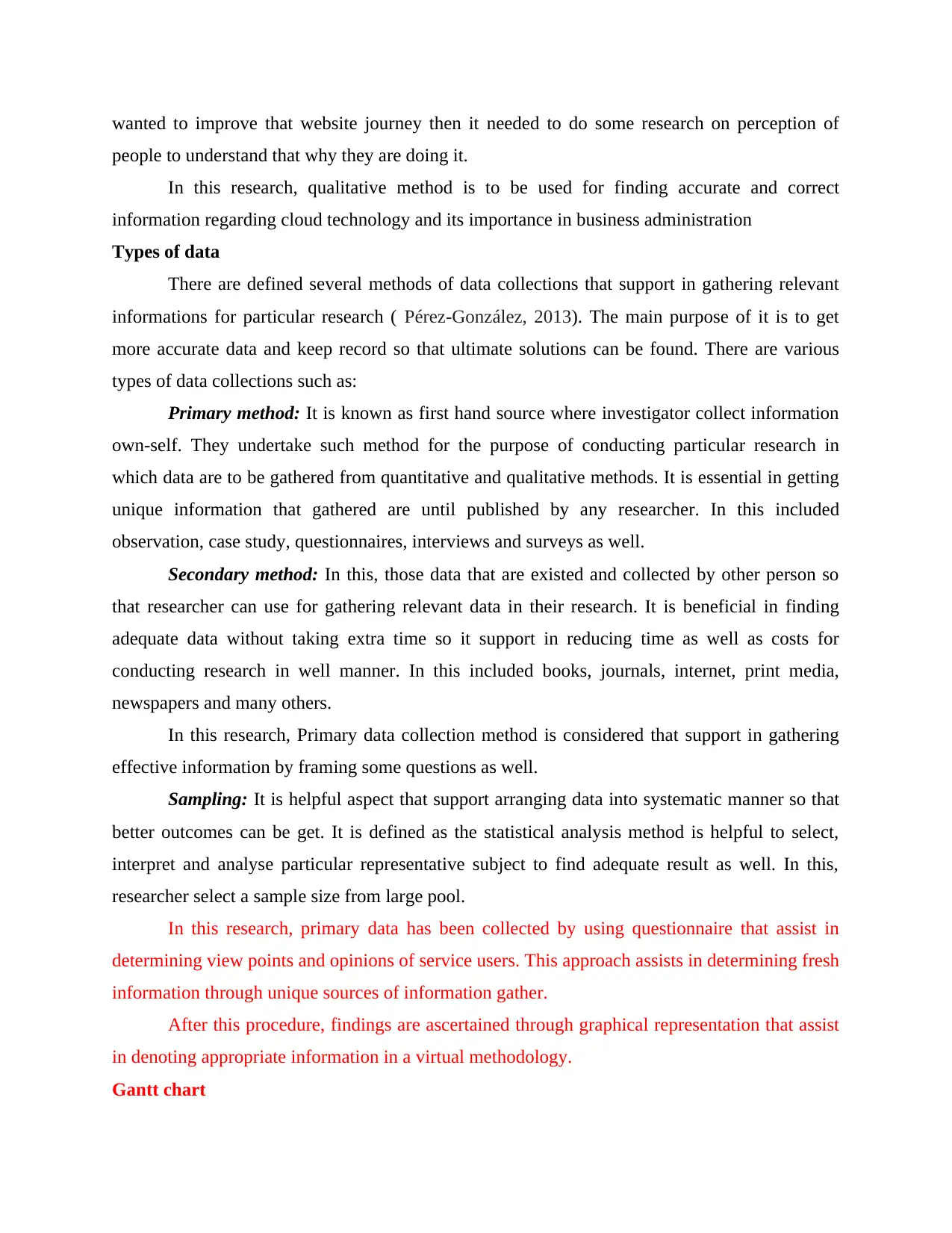
wanted to improve that website journey then it needed to do some research on perception of
people to understand that why they are doing it.
In this research, qualitative method is to be used for finding accurate and correct
information regarding cloud technology and its importance in business administration
Types of data
There are defined several methods of data collections that support in gathering relevant
informations for particular research ( Pérez-González, 2013). The main purpose of it is to get
more accurate data and keep record so that ultimate solutions can be found. There are various
types of data collections such as:
Primary method: It is known as first hand source where investigator collect information
own-self. They undertake such method for the purpose of conducting particular research in
which data are to be gathered from quantitative and qualitative methods. It is essential in getting
unique information that gathered are until published by any researcher. In this included
observation, case study, questionnaires, interviews and surveys as well.
Secondary method: In this, those data that are existed and collected by other person so
that researcher can use for gathering relevant data in their research. It is beneficial in finding
adequate data without taking extra time so it support in reducing time as well as costs for
conducting research in well manner. In this included books, journals, internet, print media,
newspapers and many others.
In this research, Primary data collection method is considered that support in gathering
effective information by framing some questions as well.
Sampling: It is helpful aspect that support arranging data into systematic manner so that
better outcomes can be get. It is defined as the statistical analysis method is helpful to select,
interpret and analyse particular representative subject to find adequate result as well. In this,
researcher select a sample size from large pool.
In this research, primary data has been collected by using questionnaire that assist in
determining view points and opinions of service users. This approach assists in determining fresh
information through unique sources of information gather.
After this procedure, findings are ascertained through graphical representation that assist
in denoting appropriate information in a virtual methodology.
Gantt chart
people to understand that why they are doing it.
In this research, qualitative method is to be used for finding accurate and correct
information regarding cloud technology and its importance in business administration
Types of data
There are defined several methods of data collections that support in gathering relevant
informations for particular research ( Pérez-González, 2013). The main purpose of it is to get
more accurate data and keep record so that ultimate solutions can be found. There are various
types of data collections such as:
Primary method: It is known as first hand source where investigator collect information
own-self. They undertake such method for the purpose of conducting particular research in
which data are to be gathered from quantitative and qualitative methods. It is essential in getting
unique information that gathered are until published by any researcher. In this included
observation, case study, questionnaires, interviews and surveys as well.
Secondary method: In this, those data that are existed and collected by other person so
that researcher can use for gathering relevant data in their research. It is beneficial in finding
adequate data without taking extra time so it support in reducing time as well as costs for
conducting research in well manner. In this included books, journals, internet, print media,
newspapers and many others.
In this research, Primary data collection method is considered that support in gathering
effective information by framing some questions as well.
Sampling: It is helpful aspect that support arranging data into systematic manner so that
better outcomes can be get. It is defined as the statistical analysis method is helpful to select,
interpret and analyse particular representative subject to find adequate result as well. In this,
researcher select a sample size from large pool.
In this research, primary data has been collected by using questionnaire that assist in
determining view points and opinions of service users. This approach assists in determining fresh
information through unique sources of information gather.
After this procedure, findings are ascertained through graphical representation that assist
in denoting appropriate information in a virtual methodology.
Gantt chart
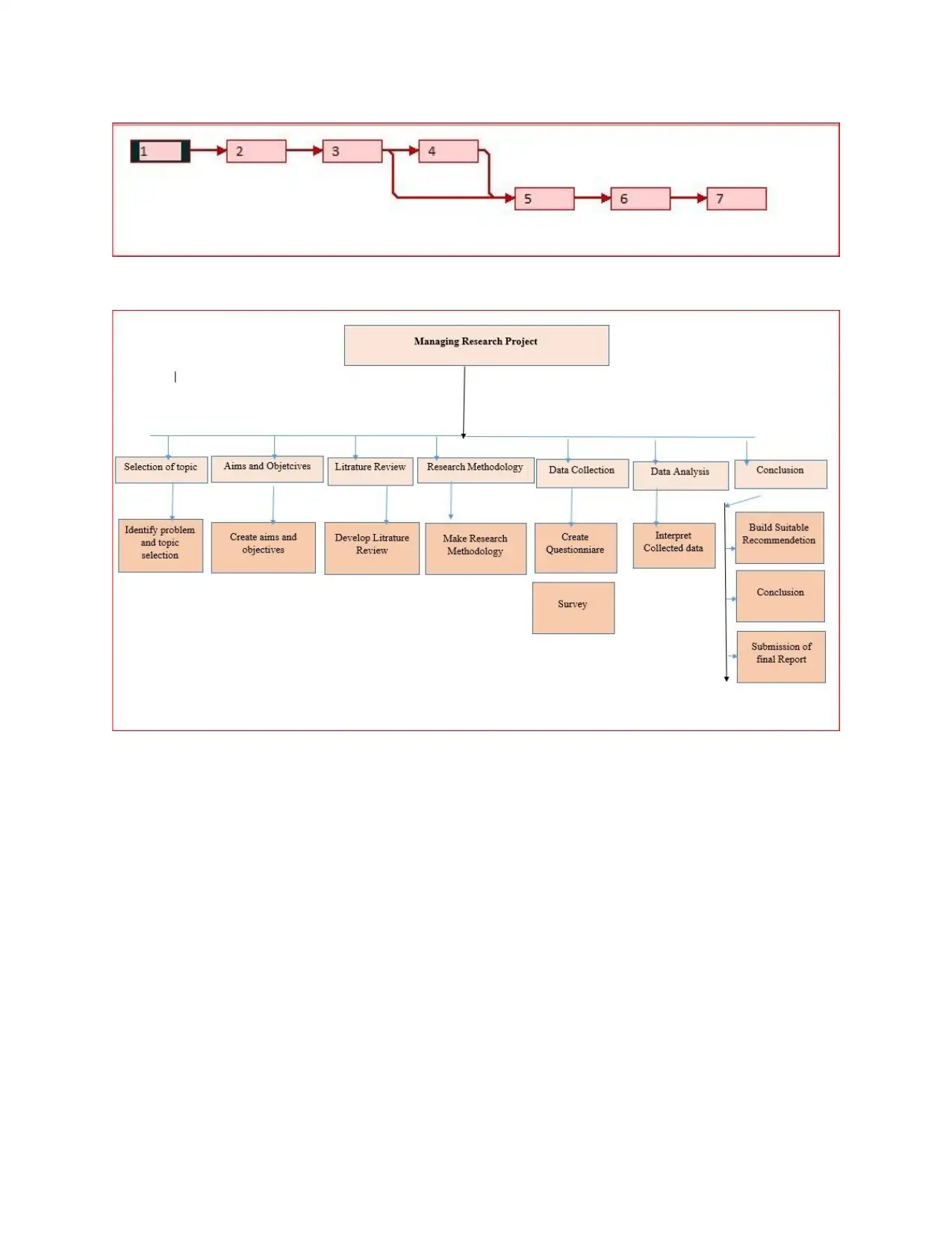
⊘ This is a preview!⊘
Do you want full access?
Subscribe today to unlock all pages.

Trusted by 1+ million students worldwide
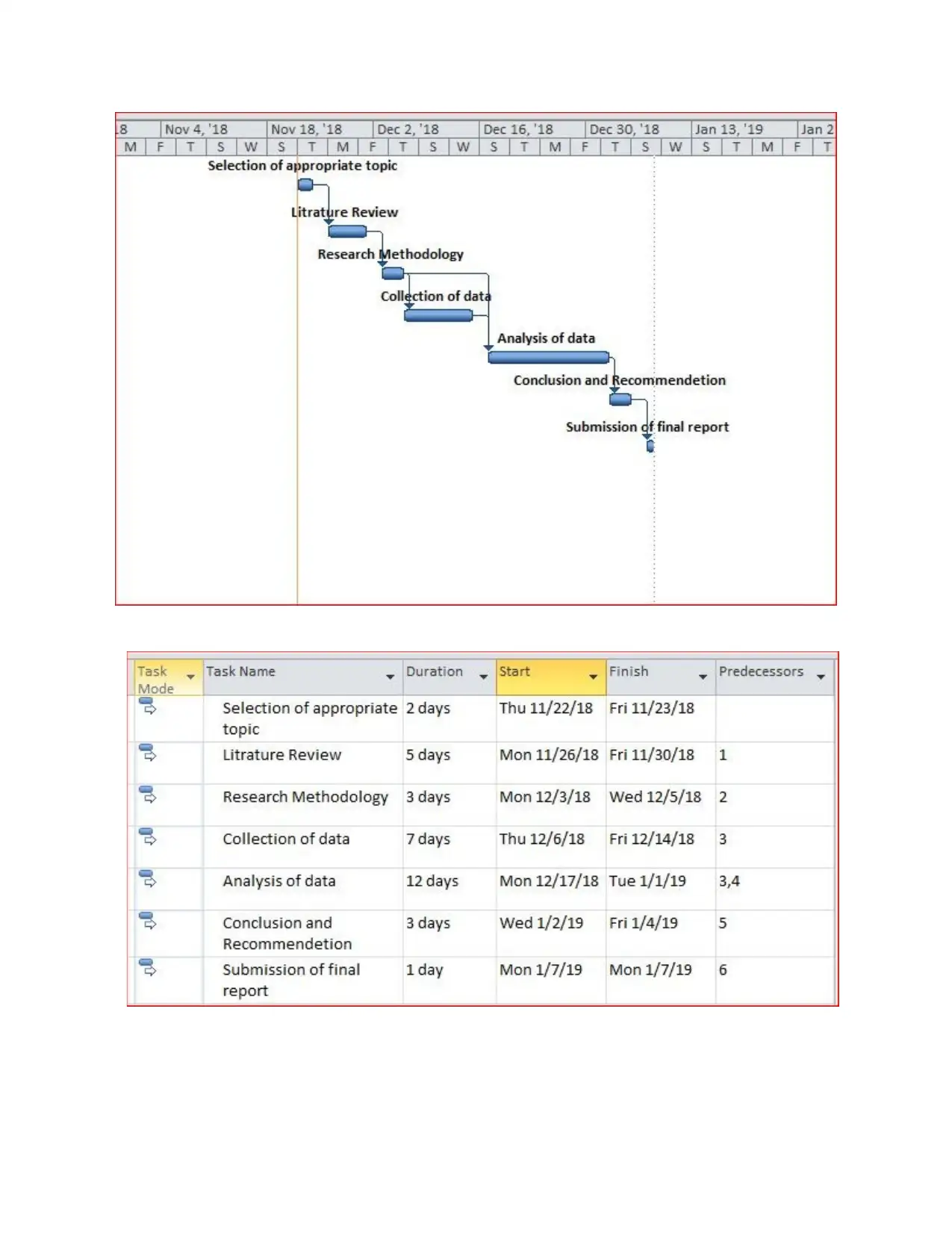
Paraphrase This Document
Need a fresh take? Get an instant paraphrase of this document with our AI Paraphraser
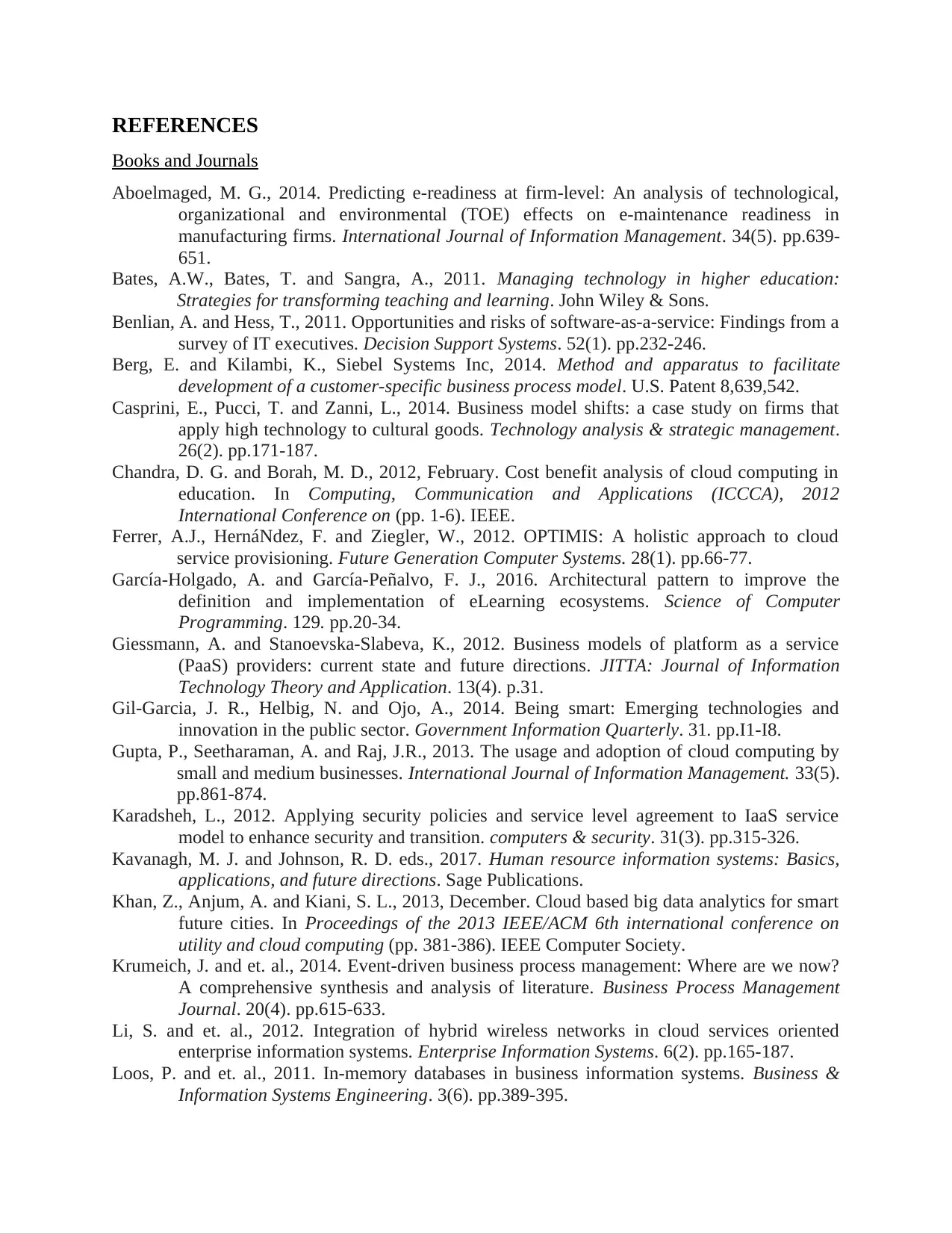
REFERENCES
Books and Journals
Aboelmaged, M. G., 2014. Predicting e-readiness at firm-level: An analysis of technological,
organizational and environmental (TOE) effects on e-maintenance readiness in
manufacturing firms. International Journal of Information Management. 34(5). pp.639-
651.
Bates, A.W., Bates, T. and Sangra, A., 2011. Managing technology in higher education:
Strategies for transforming teaching and learning. John Wiley & Sons.
Benlian, A. and Hess, T., 2011. Opportunities and risks of software-as-a-service: Findings from a
survey of IT executives. Decision Support Systems. 52(1). pp.232-246.
Berg, E. and Kilambi, K., Siebel Systems Inc, 2014. Method and apparatus to facilitate
development of a customer-specific business process model. U.S. Patent 8,639,542.
Casprini, E., Pucci, T. and Zanni, L., 2014. Business model shifts: a case study on firms that
apply high technology to cultural goods. Technology analysis & strategic management.
26(2). pp.171-187.
Chandra, D. G. and Borah, M. D., 2012, February. Cost benefit analysis of cloud computing in
education. In Computing, Communication and Applications (ICCCA), 2012
International Conference on (pp. 1-6). IEEE.
Ferrer, A.J., HernáNdez, F. and Ziegler, W., 2012. OPTIMIS: A holistic approach to cloud
service provisioning. Future Generation Computer Systems. 28(1). pp.66-77.
García-Holgado, A. and García-Peñalvo, F. J., 2016. Architectural pattern to improve the
definition and implementation of eLearning ecosystems. Science of Computer
Programming. 129. pp.20-34.
Giessmann, A. and Stanoevska-Slabeva, K., 2012. Business models of platform as a service
(PaaS) providers: current state and future directions. JITTA: Journal of Information
Technology Theory and Application. 13(4). p.31.
Gil-Garcia, J. R., Helbig, N. and Ojo, A., 2014. Being smart: Emerging technologies and
innovation in the public sector. Government Information Quarterly. 31. pp.I1-I8.
Gupta, P., Seetharaman, A. and Raj, J.R., 2013. The usage and adoption of cloud computing by
small and medium businesses. International Journal of Information Management. 33(5).
pp.861-874.
Karadsheh, L., 2012. Applying security policies and service level agreement to IaaS service
model to enhance security and transition. computers & security. 31(3). pp.315-326.
Kavanagh, M. J. and Johnson, R. D. eds., 2017. Human resource information systems: Basics,
applications, and future directions. Sage Publications.
Khan, Z., Anjum, A. and Kiani, S. L., 2013, December. Cloud based big data analytics for smart
future cities. In Proceedings of the 2013 IEEE/ACM 6th international conference on
utility and cloud computing (pp. 381-386). IEEE Computer Society.
Krumeich, J. and et. al., 2014. Event-driven business process management: Where are we now?
A comprehensive synthesis and analysis of literature. Business Process Management
Journal. 20(4). pp.615-633.
Li, S. and et. al., 2012. Integration of hybrid wireless networks in cloud services oriented
enterprise information systems. Enterprise Information Systems. 6(2). pp.165-187.
Loos, P. and et. al., 2011. In-memory databases in business information systems. Business &
Information Systems Engineering. 3(6). pp.389-395.
Books and Journals
Aboelmaged, M. G., 2014. Predicting e-readiness at firm-level: An analysis of technological,
organizational and environmental (TOE) effects on e-maintenance readiness in
manufacturing firms. International Journal of Information Management. 34(5). pp.639-
651.
Bates, A.W., Bates, T. and Sangra, A., 2011. Managing technology in higher education:
Strategies for transforming teaching and learning. John Wiley & Sons.
Benlian, A. and Hess, T., 2011. Opportunities and risks of software-as-a-service: Findings from a
survey of IT executives. Decision Support Systems. 52(1). pp.232-246.
Berg, E. and Kilambi, K., Siebel Systems Inc, 2014. Method and apparatus to facilitate
development of a customer-specific business process model. U.S. Patent 8,639,542.
Casprini, E., Pucci, T. and Zanni, L., 2014. Business model shifts: a case study on firms that
apply high technology to cultural goods. Technology analysis & strategic management.
26(2). pp.171-187.
Chandra, D. G. and Borah, M. D., 2012, February. Cost benefit analysis of cloud computing in
education. In Computing, Communication and Applications (ICCCA), 2012
International Conference on (pp. 1-6). IEEE.
Ferrer, A.J., HernáNdez, F. and Ziegler, W., 2012. OPTIMIS: A holistic approach to cloud
service provisioning. Future Generation Computer Systems. 28(1). pp.66-77.
García-Holgado, A. and García-Peñalvo, F. J., 2016. Architectural pattern to improve the
definition and implementation of eLearning ecosystems. Science of Computer
Programming. 129. pp.20-34.
Giessmann, A. and Stanoevska-Slabeva, K., 2012. Business models of platform as a service
(PaaS) providers: current state and future directions. JITTA: Journal of Information
Technology Theory and Application. 13(4). p.31.
Gil-Garcia, J. R., Helbig, N. and Ojo, A., 2014. Being smart: Emerging technologies and
innovation in the public sector. Government Information Quarterly. 31. pp.I1-I8.
Gupta, P., Seetharaman, A. and Raj, J.R., 2013. The usage and adoption of cloud computing by
small and medium businesses. International Journal of Information Management. 33(5).
pp.861-874.
Karadsheh, L., 2012. Applying security policies and service level agreement to IaaS service
model to enhance security and transition. computers & security. 31(3). pp.315-326.
Kavanagh, M. J. and Johnson, R. D. eds., 2017. Human resource information systems: Basics,
applications, and future directions. Sage Publications.
Khan, Z., Anjum, A. and Kiani, S. L., 2013, December. Cloud based big data analytics for smart
future cities. In Proceedings of the 2013 IEEE/ACM 6th international conference on
utility and cloud computing (pp. 381-386). IEEE Computer Society.
Krumeich, J. and et. al., 2014. Event-driven business process management: Where are we now?
A comprehensive synthesis and analysis of literature. Business Process Management
Journal. 20(4). pp.615-633.
Li, S. and et. al., 2012. Integration of hybrid wireless networks in cloud services oriented
enterprise information systems. Enterprise Information Systems. 6(2). pp.165-187.
Loos, P. and et. al., 2011. In-memory databases in business information systems. Business &
Information Systems Engineering. 3(6). pp.389-395.
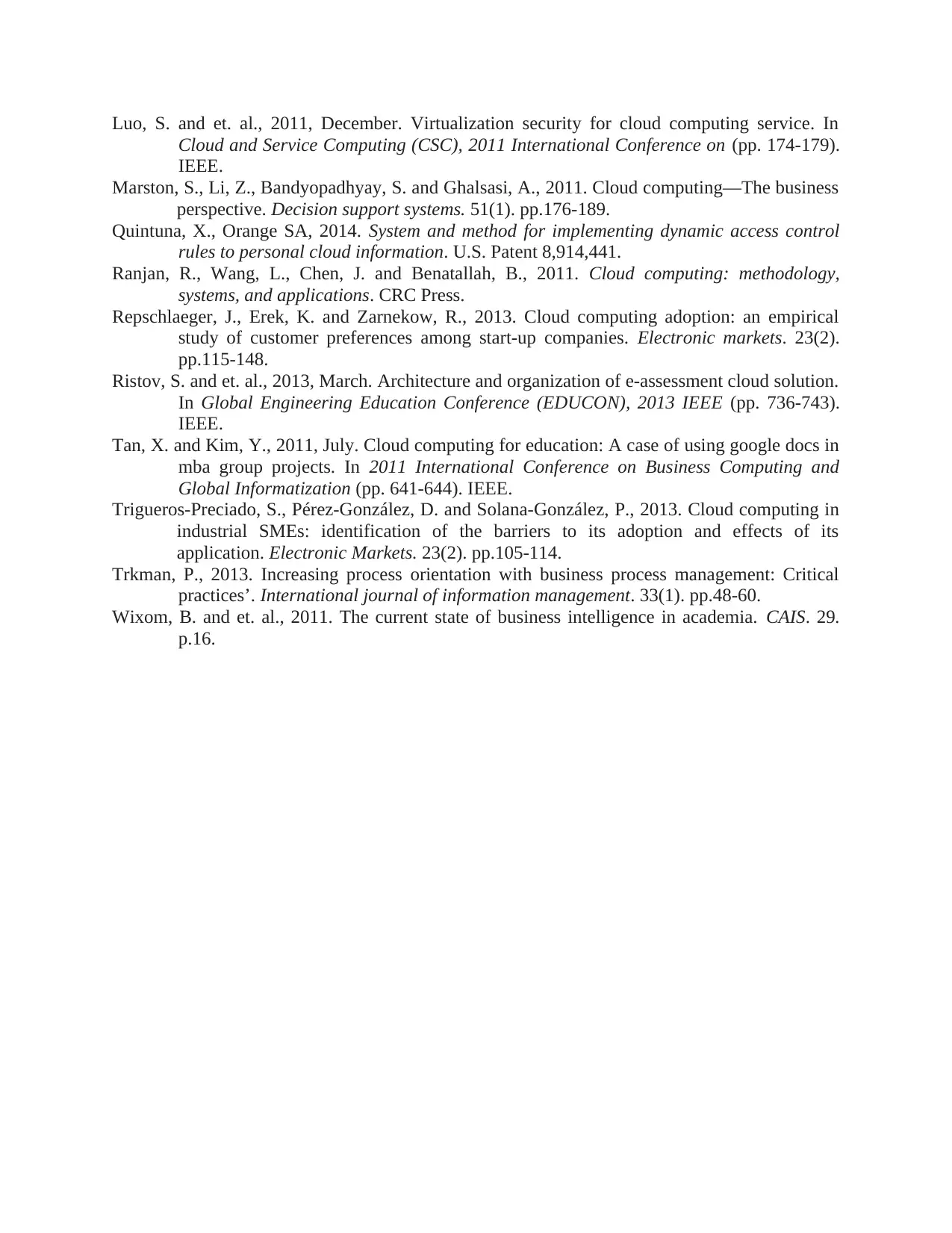
Luo, S. and et. al., 2011, December. Virtualization security for cloud computing service. In
Cloud and Service Computing (CSC), 2011 International Conference on (pp. 174-179).
IEEE.
Marston, S., Li, Z., Bandyopadhyay, S. and Ghalsasi, A., 2011. Cloud computing—The business
perspective. Decision support systems. 51(1). pp.176-189.
Quintuna, X., Orange SA, 2014. System and method for implementing dynamic access control
rules to personal cloud information. U.S. Patent 8,914,441.
Ranjan, R., Wang, L., Chen, J. and Benatallah, B., 2011. Cloud computing: methodology,
systems, and applications. CRC Press.
Repschlaeger, J., Erek, K. and Zarnekow, R., 2013. Cloud computing adoption: an empirical
study of customer preferences among start-up companies. Electronic markets. 23(2).
pp.115-148.
Ristov, S. and et. al., 2013, March. Architecture and organization of e-assessment cloud solution.
In Global Engineering Education Conference (EDUCON), 2013 IEEE (pp. 736-743).
IEEE.
Tan, X. and Kim, Y., 2011, July. Cloud computing for education: A case of using google docs in
mba group projects. In 2011 International Conference on Business Computing and
Global Informatization (pp. 641-644). IEEE.
Trigueros-Preciado, S., Pérez-González, D. and Solana-González, P., 2013. Cloud computing in
industrial SMEs: identification of the barriers to its adoption and effects of its
application. Electronic Markets. 23(2). pp.105-114.
Trkman, P., 2013. Increasing process orientation with business process management: Critical
practices’. International journal of information management. 33(1). pp.48-60.
Wixom, B. and et. al., 2011. The current state of business intelligence in academia. CAIS. 29.
p.16.
Cloud and Service Computing (CSC), 2011 International Conference on (pp. 174-179).
IEEE.
Marston, S., Li, Z., Bandyopadhyay, S. and Ghalsasi, A., 2011. Cloud computing—The business
perspective. Decision support systems. 51(1). pp.176-189.
Quintuna, X., Orange SA, 2014. System and method for implementing dynamic access control
rules to personal cloud information. U.S. Patent 8,914,441.
Ranjan, R., Wang, L., Chen, J. and Benatallah, B., 2011. Cloud computing: methodology,
systems, and applications. CRC Press.
Repschlaeger, J., Erek, K. and Zarnekow, R., 2013. Cloud computing adoption: an empirical
study of customer preferences among start-up companies. Electronic markets. 23(2).
pp.115-148.
Ristov, S. and et. al., 2013, March. Architecture and organization of e-assessment cloud solution.
In Global Engineering Education Conference (EDUCON), 2013 IEEE (pp. 736-743).
IEEE.
Tan, X. and Kim, Y., 2011, July. Cloud computing for education: A case of using google docs in
mba group projects. In 2011 International Conference on Business Computing and
Global Informatization (pp. 641-644). IEEE.
Trigueros-Preciado, S., Pérez-González, D. and Solana-González, P., 2013. Cloud computing in
industrial SMEs: identification of the barriers to its adoption and effects of its
application. Electronic Markets. 23(2). pp.105-114.
Trkman, P., 2013. Increasing process orientation with business process management: Critical
practices’. International journal of information management. 33(1). pp.48-60.
Wixom, B. and et. al., 2011. The current state of business intelligence in academia. CAIS. 29.
p.16.
⊘ This is a preview!⊘
Do you want full access?
Subscribe today to unlock all pages.

Trusted by 1+ million students worldwide
1 out of 12
Related Documents
Your All-in-One AI-Powered Toolkit for Academic Success.
+13062052269
info@desklib.com
Available 24*7 on WhatsApp / Email
![[object Object]](/_next/static/media/star-bottom.7253800d.svg)
Unlock your academic potential
Copyright © 2020–2025 A2Z Services. All Rights Reserved. Developed and managed by ZUCOL.





